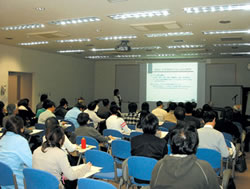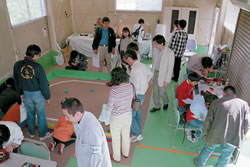International Workshop and Review Committee Meeting for Creating the Brain
The Creating the Brain Review Committee met from September 29 to October 1, 2004, and Prof. Michael Arbib of the University of Southern California presided over the 15-member committee. A workshop preceded the Review Committee meeting to discuss the future direction of Creating the Brain research. The activities of seven laboratories in this area and their potential for future contributions were considered. Here is a short summary of the results of this review.
While the disciplines of computational neuroscience and brain-style computation dominate the Creating the Brain area, mathematical neuroscience is the connecting node for these two fields and neuroinformatics provides essential technical support. The committee praised BSI’s pioneering initiative in this research area and noted the leading international position of some of its laboratories.
However, pointing to the innate difficulties in the research fields of the Creating the Brain, they also noted that actual progress fell short of its initial targets, namely: “to develop the bases for advanced new computers and communications systems, and to advance the study of computers and robots with knowledge and emotion.” Three reasons for this were identified by the Review Committee. First some theoretical laboratories put a disproportionate emphasis on experimental studies. Second they noted a lack of a shared understanding of the goals for Creating the Brain and insufficient collaboration between laboratories. The committee suggested that the area’s leadership was not strong enough to sufficiently address these issues. Finally, they found that the amount of collaboration with industry was insufficient.
Looking at the proposed direction of the area, the Review Committee supported restructuring Creating the Brain based on the existing laboratories. They proposed the following measures to guide progress.
- Appoint a new leader to Creating the Brain. This leader should have demonstrated outstanding academic achievement internationally and be well versed in current trends in theoretical and experimental neuroscience and robotics. This person should also be able to deepen industries ties and collaboration.
- By implementing more top-down management, unified goals of Creating the Brain should be explicitly stated and increased cooperation between BSI’s research laboratories forged. Brain-style computing should be carefully nurtured.
- Cultivate the skills of younger researchers within an internationally competitive arena, increase flexibility in budget allocation, and establish new laboratories. Establishing units for promising young researchers and a rolling tenure system are also recommended.
- Reinforce collaborative ties with universities and develop graduate student and post-doctorate training systems.
With these points in mind, the Creating the Brain research area will be restructured. Two new groups, the Computational Neuroscience Group and the Brain-Style Computing Group, have been established. A call for applications for new laboratories and units was announced to complement existing laboratories that should stimulate research and secure BSI’s leadership in this field around the globe.
World Brain Awareness Week 2005
BSI provided a seminar and a laboratory tour on March 12, 2005 for high-school students and teachers. This year’s focus explored “The mechanisms by which the brain learns to use tools and language” was part of the international event “World Brain Awareness Week 2005”. The day at BSI began with an opening address by Dr. Shun-ichi Amari, Director of BSI, followed by a seminar that had two lectures by laboratory heads at the Institute: “Measuring what is ‘inside the mind’” by Dr. Atushi Iriki and “Searching for the human mind through the window of language” by Dr. Reiko Mazuka. The lectures were followed by visits to five laboratories. The day ended with an enthusiastic discussion between participants and researchers, thereby providing a valuable opportunity to deeper the public’s understanding of brain science.
RIKEN Open Day
The theme for this year’s annual Science and Technology Week in Japan, from 18 to 24 April 2005, was ”It begins with the first: ’I wonder why...“”. With that in mind, researchers at the RIKEN Wako Institute opened their campus to visitors on Saturday, the 23rd of April. This beautiful spring day helped attract more than 7,000 people. BSI set-up twenty information stations. Families as well as elementary and junior high school students enjoyed the robots and other activities in the “personal experience corner”. Using displays, researchers and technicians could be seen passionately explaining their work in various places throughout BSI. In Suzuki Umetaro Hall, the laboratory head of the Laboratory for Neural Circuit Development, Dr. Takao K. Hensch, introduced his lab’s efforts to uncover the mechanisms involved in developing the brain’s circuitry and learning plasticity. His lecture was titled “Critical periods and the developing brain”. The exchanges between researchers and the public throughout Open Day were meaningful.








